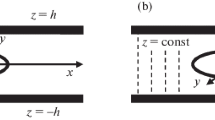In the earlier developed method of direct cutting-out, we take into account the anisotropy of material. This method is based on the procedure of modeling of finite or bounded bodies with thin structural defects of any type and boundary conditions on its contour by an infinite space with the same inhomogeneities as in the original problem and additional thin inhomogeneities (cracks or absolutely rigid inclusions), which form the boundary of the investigated body. Thus, loaded cracks are used to model boundary conditions of the first kind, whereas absolutely rigid inclusions embedded in the matrix with certain tension model boundary conditions of the second kind. The developed approach is verified for several problems of longitudinal shear of an anisotropic half space, a layer, and a wedge in the presence of an internal crack under given boundary conditions of the first kind.
Similar content being viewed by others
References
K. V. Vasil’ev, Ya. M. Pasternak, and H. T. Sulym, “Antiplane deformation of a square (in plan) body with internal thin inhomogeneity,” Visn. Lviv. Univ., Ser. Mekh.-Mat., Issue 73, 165–176 (2010).
K. V. Vasil’ev and H. T. Sulym, “Application of the method of direct cutting-out to the solution of the problem of longitudinal shear of a wedge with thin heterogeneities of arbitrary orientation,” Mat. Met. Fiz.-Mekh. Polya, 53, No. 3, 117–126 (2010); English translation: J. Math. Sci., 180, No. 2, 122–134 (2012), https://doi.org/10.1007/s10958-011-0634-x.
K. V. Vasil’ev and H. T. Sulym, “Method of direct cutting-out in the problems of piecewise homogeneous bodies with interface cracks under longitudinal shear,” Mat. Met. Fiz.-Mekh. Polya, 59, No. 4, 44–57 (2016); English translation: J. Math. Sci., 238, No. 1, 46–62 (2019), https://doi.org/10.1007/s10958-019-04217-w.
K. Vasil’ev and H. Sulym, “Method of direct cutting-out for modeling of the stress-strain state of isotropic layered media with thin inhomogeneities under antiplane deformation,” Mashynoznavstvo, No. 11-12, 10–17 (2006).
S. G. Lekhnitskii, Theory of Elasticity of Anisotropic Bodies [in Russian], Nauka, Moscow (1977).
Ia. M. Pasternak, K. V. Vasil’ev, and H. T. Sulym, “Antiplane deformation by concentrated factors of bounded bodies with cracks and rigid inclusions,” Mat. Met. Fiz.-Mekh. Polya, 55, No. 1, 72–83 (2012); English translation: J. Math. Sci., 190, No. 5, 710–724 (2013), https://doi.org/10.1007/s10958-013-1282-0.
H. T. Sulym, Foundations of the Mathematical Theory of Thermoelastic Equilibrium of Deformable Solids with Thin Inclusions [in Ukrainian], Dosl. Vyd. Tsentr NTSh, Lviv (2007).
H. T. Sulym and Ya. M. Pasternak, “Application of the J-integral for the investigation of longitudinal shear of anisotropic bodies with thin-walled strip-like inclusions,” Visn. Donetsk Univ., Ser. A: Pryrod. Nauky, Issue 2, 88–92 (2006).
H. T. Sulym and Ia. M. Pasternak, “Application of the boundary-element method for analysis of the antiplane shear of anisotropic bodies containing thin-walled structures,” Mat. Met. Fiz.-Mekh. Polya, 51, No. 4, 136–144 (2008); English translation: J. Math. Sci., 167, No. 2, 162–172 (2010), https://doi.org/10.1007/s10958-010-9912-2.
H. T. Sulym and S. P. Shevchuk, “Longitudinal shear of layered anisotropic media with band-type inhomogeneities,” Mat. Met. Fiz.-Mekh. Polya, 41, No. 3, 90–97 (1998); English translation: J. Math. Sci., 104, No. 5, 1506–1514 (2001).
S. P. Shevchuk, “Influence of an elastic strip-like inclusion on the deformation of the surface of anisotropic half space in longitudinal shear,” Mat. Met. Fiz.-Mekh. Polya, 49, No. 3, 125–130 (2006).
V. Bozhydarnyk, Ia. Pasternak, H. Sulym, and N. Oliyarnyk, “BEM approach for the antiplane shear of anisotropic solids containing thin inhomogeneities,” Acta Mech. Automat., 5, No. 4, 11–16 (2011).
R. T. Faal, S. J. Fariborz, and H. R. Daghyani, “Antiplane deformation of orthotropic strips with multiple defects,” J. Mech. Mater. Struct., 1, No. 7, 1097–1114 (2006).
H. G. Georgiadis, “Complex-variable and integral-transform methods for elastodynamic solutions of cracked orthotropic strip,” Eng. Fract. Mech., 24, No. 5, 727–735 (1986).
M. Ghadiri and A. R. Shahani, “Mode III fracture analysis of an anisotropic finite wedge with an interfacial crack,” Math. Mech. Solids, 18, No. 8, 823–836 (2012).
W. K. Lee and Y. Y. Earmme, “An interfacial edge crack in anisotropic bimaterial under anti-plane singularity,” Int. J. Fract., 104, No. 1, 15–22 (2000).
X.-F. Li and X.-Y. Duan, “An interfacially cracked orthotropic rectangular bimaterial subjected to antiplane shear loading,” Appl. Math. Comput., 174, No. 2, 1060–1079 (2006).
X.-F. Li and K. Y. Lee, “Closed-form solution for an orthotropic elastic strip with a crack perpendicular to the edges under arbitrary anti-plane shear,” ZAMM Z. Angew. Math. Mech., 89, No. 5, 370–382 (2009).
Ia. Pasternak, R. Pasternak, and H. Sulym, “A comprehensive study on Green’s functions and boundary integral equations for 3D anisotropic thermomagnetoelectroelasticity,” Eng. Anal. Bound. Elem., 64, 222–229 (2016).
Y. Pasternak and H. Sulym, “Boundary-element analysis of anisotropic thermomagnetoelectroelastic solids with 3D shell-like inclusions,” Acta Mech. Automat., 11, No. 4, 308–312 (2017).
A. R. Shahani, “Mode III stress intensity factors for edge-cracked circular shafts, bonded wedges, bonded half planes and DCB’s,” Int. J. Solids Struct., 40, No. 24, 6567–6576 (2003).
A. R. Shahani, and M. Ghadiri, “Analysis of anisotropic sector with a radial crack under anti-plane shear loading,” Int. J. Solids Struct., 47, No. 7-8, 1030–1039 (2010).
G. Sulym and S. Shevchuk, “Antiplane problem for anisotropic layered media with thin elastic inclusions under concentrated forces and screw dislocations,” J. Theor. Appl. Mech., 37, No. 1, 47–63 (1999).
H. Sulym, Ia. Pasternak, and R. Pasternak, Boundary-Element Analysis of Multifield Materials: Recent Studies with Application to Crack and Thin Inclusion Problems, Scientific Thesis No. 274, Library of Mechanics, Printing House of the Białystok University of Technology, Bialystok (2015).
X.-Fa. Wu, Y. A. Dzenis, and W.-S. Zou, “Interfacial edge crack between two bonded dissimilar orthotropic strips under antiplane point loading,” ZAMM Z. Angew. Math. Mech., 83, No. 6, 419–422 (2003).
Author information
Authors and Affiliations
Corresponding author
Additional information
Translated from Matematychni Metody ta Fizyko-Mekhanichni Polya, Vol. 61, No. 3, pp. 89–100, July–September, 2018.
Rights and permissions
About this article
Cite this article
Vasil’ev, К.V., Sulym, H.Т. Method of Direct Cutting-Out in the Problems of Elastic Equilibrium of Anisotropic Bodies with Cracks Under Longitudinal Shear. J Math Sci 254, 103–116 (2021). https://doi.org/10.1007/s10958-021-05291-9
Received:
Published:
Issue Date:
DOI: https://doi.org/10.1007/s10958-021-05291-9



